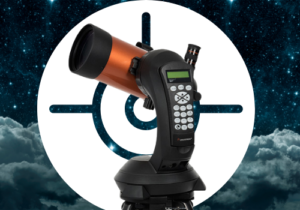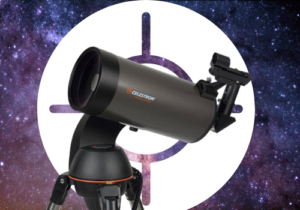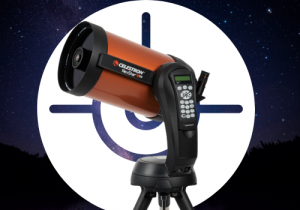Celestron NexStar 130SLT Review: Don’t Buy Before Reading This
Disclosure: This post contains affiliate links and I may earn a small commission (at no extra cost to you) if you click through and make a purchase. Thanks in advance – I really appreciate it!
Right off the bat, I can assure you that Celestron 130SLT is a small but mighty Newtonian reflector that can show you the moon, planets, and many deep-sky objects (DSOs) without burning a hole in your pocket.
If you’re seriously considering this telescope, then read this Celestron 130SLT review till the end as I’ll cover the Nexstar 130SLT’s strengths and shortcomings in detail which will ultimately help you decide whether the Celestron Nexstar 130SLT is a telescope worth investing in.
My Verdict
For the low price, an array of included accessories, and a 2-year warranty, the NexStar 130SLT is a good buy if you’re looking for an affordable GoTo telescope with a decent aperture. The 5” aperture is good enough for viewing the moon’s surface details, planets, and many bright DSOs. The optics of NexStar 130SLT are one of the best among low-budget, beginner models. The parabolic mirrors are multi-coated and produce images that are crisp, clear, and without any chromatic aberration. The biggest downside of this telescope is the mount which is certainly of high quality, but it is simply a tad too small and weak for the telescope. That said, I can recommend this as one of the best-computerized telescopes for beginners without any problems or complaints. As long as you can find a stable surface and work around the shaky mount, you will have hours and hours of fun with this amazing piece of technology.
Pros
- Light, portable, and affordable.
- Wide field of views.
- Computerized go-to tracking.
- Decent aperture and light intake.
- Easy to align.
- Compatible with 2″ eyepieces.
- 2-Year warranty.
Cons
- Shaky tripod.
- May vibrate while slewing.
- Drains batteries quickly.
- Not for serious astrophotography.
- Optical Design: Newtonian Reflector
- Aperture: 130 mm / 5.1
- Focal Length: 650 mm
- Focal Ratio: f/5
- Mount: Motorized; Alt-Azimuth
- Finderscope: StarPointer – Red Dot Finder
- Eyepieces: 25mm and 9mm
Prices pulled from the Amazon Product Advertising API on:
Product prices and availability are accurate as of the date/time indicated and are subject to change. Any price and availability information displayed on [relevant Amazon Site(s), as applicable] at the time of purchase will apply to the purchase of this product.
Celestron NexStar 130SLT Review
The Celestron NexStar 130 SLT is an excellent future-proof telescope for beginners and novice astronomers as it packs in many excellent features.
The Celestron NexStar 130SLT is a respectable computerized Newtonian reflector that has the potential to be a long-lasting telescope.
With the familiar and easy-to-understand alt-az movement, you can easily find objects and keep up to speed with GoTo to learn the night sky.
Moreover, the telescope comes from Celestron which is one of the top telescope manufacturers in the world. Their customer service is amazing, and the telescope’s build quality is very robust and portable.
Celestron NexStar SLT Series
The NexStar 130SLT is the largest telescope in the Celestron NexStar SLT line up of 4 telescopes.
The NexStar SLT Series by Celestron is designed to be an affordable, entry-level series for different types of interests.
The other telescopes in the NexStar SLT range are NexStar 90SLT, NexStar 102SLT & NexStar 127SLT.
Who Should Buy the NexStar 130SLT?
The NexStar 130SLT is best suited to beginner and intermediate level users. It could serve as a great first computerized telescope. It’s lightweight, easy to use, and obviously, its computerized design enables the user to learn a lot about sky objects.
If you are like old me, terrible at locating objects in the night sky, and get frustrated by fiddling with adjustment knobs then this is a telescope for you.
With its GoTo functionality, all you have to do is enter a few details into the hand controller, and the telescope will point itself at any one of 40,000 different objects in its memory.
Also, if you’re someone who doesn’t have much time to invest in stargazing because you may have other hobbies, then this automatic computerized telescope is for you.
Keep in mind that with an aperture just over 5” wide, this telescope is quite a light bucket and it can show you great views of the moon, planets as well as the DSOs.
Optical Performance
The Celestron NexStar 130SLT is a classic Newtonian reflector that boasts a 130mm primary aperture. This works out to just over 5” in size.
The focal length of this telescope is 650mm.
This is a fast f/5.0 (divide 650 by 130) telescope. It means that it is very good for faint objects like nebulas or galaxies.
It is large enough to give distinguished views of everything from the crater’s on the moon to individual arms on a distant spiral galaxy.
This NexStar 130 SLT scope delivers a level of crispness and clarity that most budget telescopes are unable to equal.
The primary mirror is a parabolic mirror that’s aluminum multi-coated. The coatings enhance light reflection and bump up the contrast, so you’ll be able to enjoy more detail and crispness when viewing objects.
Compared to the competition, the optics of the NexStar 130mm are every bit as good as anything you’ll see in this price range.
The Celestron NexStar 127SLT has been featured in the following articles:
Eyepieces
Celestron supplies two Plossl eyepieces with the NexStar 130SLT.
The “wider” of the two, the 25mm, is about right to stare at galaxies or – with an added lunar filter – at the moon.
The “tighter,” a 9mm, will show you larger details on planets. But you will probably want a higher power eyepiece or a Barlow lens to see moons of Jupiter and Saturn.
The 9mm and 25mm eyepieces provide 72x and 26x magnification respectively.
You have to upgrade the eyepiece collection if you want more magnification.
Or you can use a Barlow lens that will double or triple the magnification provided with each eyepiece, but it will slightly decrease the quality of the image.
This NexStar 130SLT is also compatible with 2″ eyepieces.
What Can You See With NexStar 130SLT?
The Celestron NexStar 130SLT’s wide field of view and decent aperture size makes it perfectly suitable for viewing bright deep-sky objects, such as open star clusters like M11, M45, and other Messier objects.
You’ll be able to spot the Orion Nebula or the Swan quite easily.
You can also see Andromeda and a few other galaxies.
The 130SLT can show you crisp images of the moon’s surface and planets.
With the help of a 2x Barlow lens, you’ll be able to see cloud belts & red spot of Jupiter, the Cassini division in Saturn’s rings, and the surface features of Mars.
When they are visible, you can also see Venus and Mercury’s phases.
With 130SLT, Jupiter’s and Saturn’s moons are also quite easy to spot.
Uranus and Neptune are too far to be seen clearly with any telescope, and with NexStar 130SLT you can only see them as the bluish disc in the sky.
Mount Capabilities
1. Computerized Mount
The NexStar 130SLT’s mount is well-made and easy to transport. Its legs are 1.25″ stainless steel but this setup is a little lightweight.
The only issue I found with this mount is that it’s just strong enough to handle the weight of the telescope’s optical tube.
As a result, it suffers from noticeable vibration issues when locating objects, which is most obvious at higher magnifications.
But these vibrations stop once the telescope has located the sky object.
It’s not a deal-breaker but I thought it would be worth mentioning.
That said, I have found out that most low-priced computerized telescopes from major brands have this issue of vibrating mount.
The 130SLT’s vibrations are not worse than any other telescope in its category, but there are ways to deal with it such as using anti-vibration pads or even a piece of thick folded cloth placed underneath the mount.
2. Finding & Tracking Targets
The computerized mount is the best feature of this telescope. You don’t have to spend time looking for objects manually.
The NexStar 130 SLT comes with Celestron’s NexStar+ hand controller, which is equipped with their SkyAlign technology.
The only thing you have to do here is to press the button, and the telescope will automatically slew to the object.
The hand controller has over 40, 000 objects in the database and also the tour feature of the best current objects in the sky. This is a big advantage of the computerized mount, and beginners will enjoy it.
Sadly, many of the 40,000 objects in the database are too faint for the 5″ telescope to reveal, but there are hundreds of objects that this telescope can show you.
Prices pulled from the Amazon Product Advertising API on:
Product prices and availability are accurate as of the date/time indicated and are subject to change. Any price and availability information displayed on [relevant Amazon Site(s), as applicable] at the time of purchase will apply to the purchase of this product.
3. SkyAlign Technology
Celestron’s SkyAlign system is a masterpiece. It lets you use objects in the night sky to set up the scope’s tracking without knowing which they actually are.
You may struggle the first time using SkyAlign, but you will learn it quickly.
All you have to do is level the tripod; then tell the system your rough location, plus the date and time. Then just introduce the telescope to any three bright objects in the sky.
The telescope will then process this information and it will locate itself in the world and within no time it will be ready to show you the objects that you enter in its controller.
Just select the planet, galaxy, nebula, you’d like to observe, and the motorized mount takes its instructions from the database and points the telescope towards that object.
Power Struggle
The mount is powered by 8xAA Batteries that are not included. Even when you’ll use 8 AA batteries to power this telescope, they will run out in no time, 5-6 hours max.
I highly recommend buying a 12V AC adapter or Celestron’s PowerTank (Amazon links open in new tabs).
Astrophotography
This telescope is not meant for serious astrophotography.
The NexStar 130SLT’s mount is not strong and suitable for heavy-duty DSLR imaging.
The mount has a limited payload so attaching a DSLR to it would be out of the question.
However, you can still use this telescope for short exposure astrophotography using smaller CCD cameras to take pictures of bright sky objects.
So basically, you can get your feet wet in astrophotography with 130SLT but look at the best telescopes for astrophotography if you are planning to develop your astrophotography skills.
What I Didn’t Like About NexStar 130SLT
As I mentioned before, the weight of the OTA pushes the payload capacity of the tripod and as a result, the mount suffers from vibrations while it’s slewing towards the target especially at higher magnifications.
Some users have reported failure to boot and other software glitches which are quite common in a complex piece of equipment such as the NexStar 130SLT because it has multiple levels of software, firmware, and hardware that are working together.
None of these issues were very serious and almost all of them were resolved by Celestron’s excellent US-based customer support system.
Keep in mind that the NexStar 130SLT is a reflector telescope so it is prone to being misaligned due to the fragile nature of the precise mirrors it uses.
Celestron doesn’t include a focuser or any type of collimation tool so if the telescope gets too misaligned users are going to have to search around for additional resources to help them get it back into shape.
You can buy a laser collimation tool that will do the job in seconds. All you have to do is to play with the adjustment knobs of the primary mirror to collimate the telescope.
Included Accessories
The telescope doesn’t come with that many accessories.
The NexStar 130SLT telescope kit only includes two eyepieces, a 25mm, and a 9mm, a finderscope, and a 2-year warranty certificate. That is it.
It also comes with the tripod and an accessory tray but those aren’t so much add ons as standard kits for these packages.
The finderscope is a simple red dot affair.
Celestron includes The Sky and First Light software, which is an excellent way to supplement your knowledge of the sky.
Conclusion
The Celestron Nexstar 130SLT is a fairly solid reflector computerized telescope that will work well enough for a beginner to a casual astronomer who just wants to easily locate objects, provided they’re willing to read and follow the instructions in the beginning.
If you’re willing to accept the lightweight shaky tripod and find a DIY solution to fix this minor issue, then NexStar 130SLT, due to its general value for money is a solid pick.
Written by:

Jason Parnell
At 15, I sold my bike to buy my first telescope. I spent the next 3 years sketching as many Messier objects as I could find from my garden, then at the age of 18, I discovered beer. I have wandered through California's Mojave Desert with other amateur astronomers in search of the best stargazing experience.
ABOUT US
We are a team of active amateur astronomers, here to help you with all your astronomy and science related needs – this is anything, from reviewing the latest telescopes to be released to talking about gravity and neurons. The Big Bang Optics was started because of our love for astronomy and to help others like us find the best telescope and accessories.
LEGAL DISCLAIMER
The Big Bang Optics is a participant in the Amazon Services LLC Associates Program, an affiliate advertising program designed to provide a means for sites to earn advertising fees by advertising and linking to Amazon.com. The Big Bang Optics also participates in affiliate programs with Clickbank and other sites. The Big Bang Optics is compensated for referring traffic and business to these companies.





